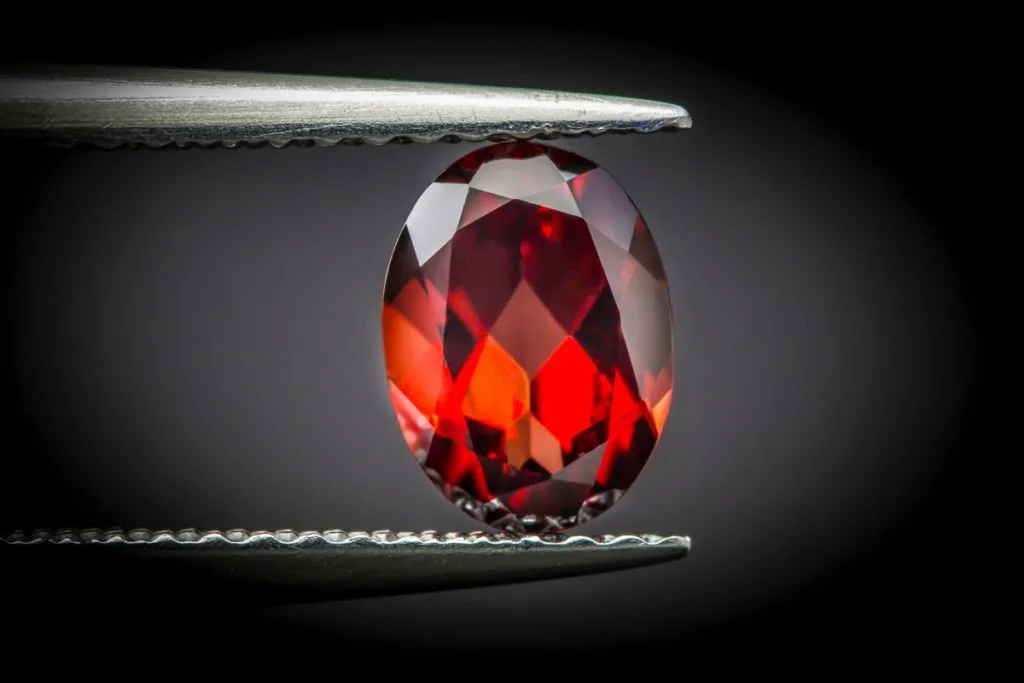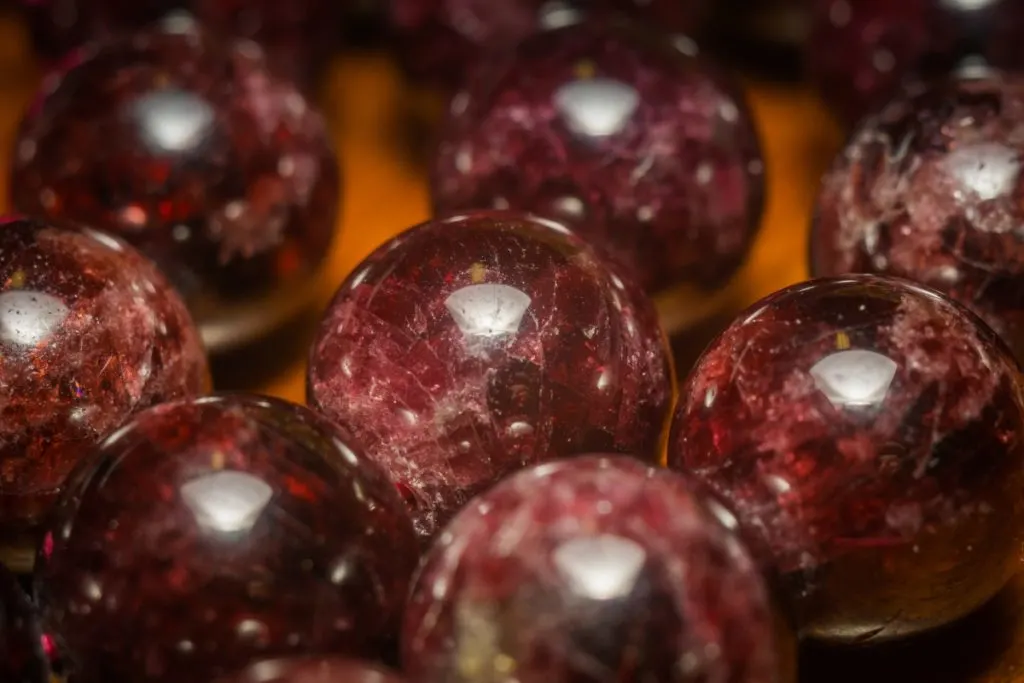As an Amazon Associate, I earn from qualifying purchases with no additional costs for you.
There are more than twenty kinds of garnets, but only five are good enough to cut and shine. They are called almandite, pyrope, andradite, grossularite, and spessartine. Each one has the same crystalline structure, which is what makes them great for cutting and cleaning. However, their chemical makeup is different.
You can cut and shape garnets with wet-dry sandpaper and some water or the engraving attachment on a Dremel. Only tumbling-grade garnets should be polished in a rock tumbler. For a final polish by hand, use some aluminum oxide polishing compound on a piece of denim or Dremel’s polishing wheel.
Before you can proceed with cutting and polishing a garnet, you must remove any rock matrix and dirt that may still be present. The garnet should be examined with a jeweler’s loupe or magnifying glass to look for inclusions and fractures, and then the optimal shape for the garnet should be determined.

If you want to check out the best books about rock and mineral identification, you can find them here (Amazon link).
Is Garnet Hard To Cut?
Garnets range in hardness between 6.5 and 7.5 on the Mohs hardness scale, so they are hard enough for jewelry. Pyrope, spessartine, almandine and tsavorite are harder than most. They are not hard to cut, and many gem cutters love them, saying they can be cut into just about any shape.
To bring out the best in a garnet, it must be faceted after being shaped. How you do this depends on the shape and size of the garnet.
Cutting facets into gemstones is a skill and an art that requires a faceting machine for the best results. You can try faceting garnets at home using some basic items, but valuable stones should be taken to a gem cutter.
Cleaning Garnets With Vinegar (Before Cutting & Polishing)
Cleaning a garnet with dish soap, water, and a gentle cloth is the most secure technique. Do not make use of a steam purifier. It is also possible to use an ultrasonic cleaner to clean garnets with no cracks.
If some rock matrix is still adhered to the garnets, you can add a few ounces of vinegar to the soap and water solution by soaking them for a few hours. This will help remove any remaining rock matrix. The stone should then be washed with a cloth and scrubbed with a toothbrush to remove any dirt and stains that may still be present.
TIP: It’s challenging to differentiate between fake and real garnets without gemological equipment. Check out the main differences between real and fake garnets in the article below:
Real vs. Fake Garnet: Focus on These 6 Differences
How To Cut Raw Garnet
Check out these six simple steps on how to cut raw garnets:
Step One
Assemble your equipment. You will need a chopping board, tap water, a tea towel, and four sheets of wet-dry sandpaper – one hundred and eighty grit, four hundred grit, six hundred grit, and twelve hundred grit. Examine your garnet to see how best to shape and cut it and where the facets should be located.
Step Two
Perform the garnet into the desired shape and remove any unwanted inclusions in the raw stone. Use the coarsest grit sandpaper first. Lay the tea towel on the work surface to prevent slippage, and attach the sandpaper firmly to the cutting board with the rough side up.
Place the cutting board on the tea towel. Put a few drops of water in the middle of the sandpaper. Rub the edges of the garnet over the surface of the sandpaper until it is the shape you want, grinding away any rough edges and flaws.
Step Three
If your garnet has flattened sides, rub each of them back and forth against the sandpaper to smooth them and bring them out more. Alternately, use sandpaper to create some facets. Rub each facet flat against the paper.
Step Four
Remove the one-eighty-grit sandpaper from the chopping board and affix the four-hundred-grit sandpaper.
Rinse the garnet in water to remove the grit and dust from the previous sandpaper. Put some water in the middle and rub each facet of the garnet repeatedly back and forth against the sandpaper.
TIP: The almandine garnet is the most common type in the United States. Check out the best environments and exact locations where to find garnet in the article below:
Where to Find Garnet: 4 Best Locations Near Me (United States)
Step Five
Repeat step four for the six hundred and twelve hundred grit sandpaper. Don’t forget to rinse the garnet before moving on to a finer grit, and be sure to wet the middle of each sheet of sandpaper. Remember to grind all of the facets of the garnet using each grit size.
You can rub the garnet in a circular motion on the sandpaper now and then to ensure a smooth surface and edges.
Step Six
Polish the stone using denim cloth and some polishing compound.
BTW: Do you want to know more about rock and mineral identification? The books listed below are the best ones you can find on the internet (Amazon links):
- Smithsonian Handbooks: Rocks & Minerals
- Gemstone & Crystal Properties (Quick Study Home)
- Ultimate Explorer Field Guide: Rocks and Minerals (National Geographic Kids)
Cutting Garnet With A Dremel
Dremels come with many attachments that can be used for cutting and polishing a garnet. You can use the engraver attachment to cut your garnet, but first, practice your technique on a hard, smooth pebble. You will need a vice, clamp, or dop stick to hold the garnet while you cut it.
Using a fine-tip marker, draw the shape you want on the stone. Dremels with variable speed settings are preferable to only a single-speed tool. Starting slowly, pull the tip of the bit along the lines you have marked evenly and without hesitation.
Allowing the bit to remain in one spot for too long will make a deeper cut within the line, making it uneven. Faster speeds remove more of the stone, making it easier to make a mistake.
TIP: The best tools for polishing rocks and adding a soft glimmer are the rotary dremels. Check out the best dremels in the article below:
3 Best Dremels for Polishing Rocks & Crystals + Accessories
How To Polish Garnet At Home

Once you have finished cutting, smoothing, and shaping the garnet, rinse and dry it. You can then polish it by rubbing it briskly on a denim cloth, felt, or leather piece. When you have rubbed it as shiny as possible, apply some polishing agent to the fabric and rub the stone for that extra shine.
You can buy polishing agents such as aluminum oxide, cerium oxide, tin oxide, or silicon dioxide from rock shops. Some say that aluminum oxide works best for garnets.
Polishing Garnet Stones In A Rock Tumbler
Many garnets aren’t worth polishing in a tumbler because they have too many fractures or pits and may crumble.
Before tumbling, examine the stones closely for any fractures or significant inclusions, as they will only worsen in a tumbler. If you have some robust, good-quality specimens, you can give it a try.
You can polish garnets in the tumbler with jasper or agate, starting with a medium grit and working to the finest.
Garnets are usually small stones, and you are unlikely to have enough to fill a tumbler unless you have bought some in bulk, especially for tumbling. Use TXP aluminum oxide for the final polish.
TIP: Buying a rock tumbler can be daunting for a beginner. Check out the ultimate buying guide on the best rock tumblers in the article below:
Best Rock Tumblers in 2022: Beginner and Hobbyist Options
Polishing Garnet Stones With A Dremel
Once you have cut and ground your garnets to the right shape and size, wash them and dry them. Use the polishing or buffing attachment to bring them to a shine.
This attachment looks like it has a small piece of felt on the end. You can dip the polishing wheel in a polishing compound and leave it there for a couple of minutes while the Dremel runs to ensure it is adequately coated.
Apply the polishing compound to the garnet’s surfaces with the Dremel. It’s best to use a Dremel to hold the garnet in a vice or clamp.
Conclusion
You can easily cut and polish a garnet at home using sandpaper, a cutting board, and some water or a Dremel. This process is not difficult and can be accomplished with little effort.
It is feasible to polish garnets in a rock tumbler; however, this is only viable if they are of tumbling grade. This is because many garnets have inclusions and fractures that render them unsuitable for tumbling. To get the desired level of shine, you can use a polishing compound and a piece of denim or the polishing wheel with a Dremel.
TIP: Garnet is a highly valued gemstone. Do you know what makes garnet so valuable? Check out the explanation in the article below:
5 Crucial Factors of Garnet Value: What’s the Garnet Worth?
